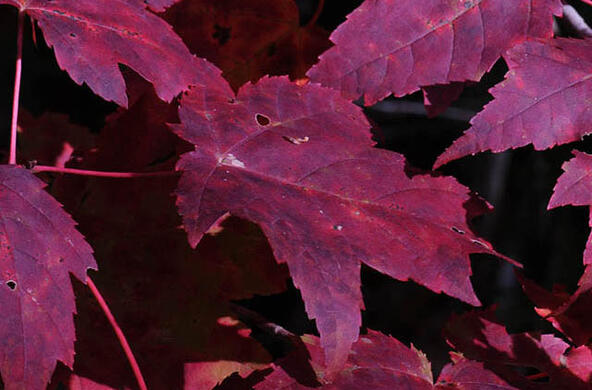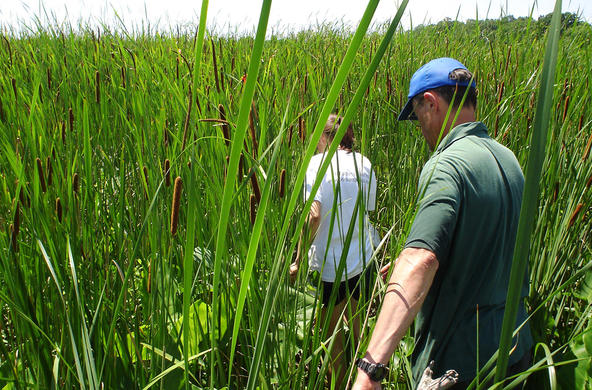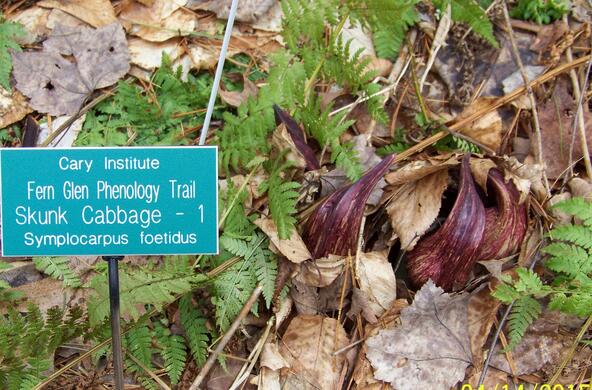Objectives
Students will be able to define a population of dandelions and understand why distribution and abundance of individuals is important.
Overview
Rating:
In this lesson students will calculate an estimate of the number of dandelions growing in their schoolyard. They will learn a common subsampling protocol used by ecologists to estimate population size. Students will help set up the experiment, collect data, and calculate their results.
Materials
- 2 Measuring tapes at 15m long for marking the study plot
- 2 metal stakes, one for the study plot and one for marking the center of the sampling plot
- 1 1m measuring tape with "eyelet" at the end
- Field guides for dandelions
- Data sheet on clipboard or piece of firm cardboard
- Random numbers table or other way to choose random numbers
Procedure
Engage
Begin by bringing in some examples of dandelion plants with unopened buds or no flowers , or bring students outside to a grassy area and see if students can identify the plants just by looking at leaves. Then show students the plant with the flower and again ask for identification. Have a brief discussion about what students think about dandelions and why it might be important to know how many are in their lawn. Define the word population and describe that when you are discussing the number of dandelions in a lawn you are discussing population size. Ask students to come up with their own example of a population. Then ask how they can figure out how to determine the population size. Discuss that measuring population size is a necessary step in addressing one of the BIG QUESTIONS in ecology: What factors determine the population size of a species in a given place?
Explore
1.Have students predict the number of dandelions they think they will find in the plot, have them give a reason for their predictions. Before setting up the plots, make a list with the students of other observations about the site (is it shady? a high traffic area? what other plants do they see? etc)
2. Define the area you will be studying. Layout a 10m x 10m study plot (teachers may want to do this in advance or if there is time it may be done with students)
- Choose the part of the schoolyard lawn you want to study.
- Mark the lower left corner with one of the metal stakes, running it through the metal tab of the first meter tape.
- Run the tape along one of the sides of the plot to just beyond 10m.
- Run the second meter tape out in a roughly perpendicular direction and use the second stake to mark the 10m point along this side.
- Square the plot corners by using the second meter tape and measuring 14m, 14cm from the 10m point on first tape to the second stake. Adjust the stake accordingly.
- Go back and lay the second tape out from the first corner stake to this point, and you have two sides of a perfectly square 10m x 10m study plot (see diagram below).
3. Identify random locations for sampling (time permitting this may be done with student or you might want to do this in advance).
- Randomly pick 10 spots to sample in your 10m x 10m plot. You can use a random numbers table to pick random coordinates for 10 sample points, blow up a balloon partially, let it go and sample where it lands, or draw coordinates out of a hat. Record these coordinates on the data sheet.
- Go to each sample point by proceeding to the appropriate point along one of the measuring tapes, then moving into the plot until you're adjacent to the appropriate point on the other tape.
4. Sample dandelions. First demonstrate to the students how to set up the circular plot using the procedure that follows. Alternatively you may use hula hoops to delineate plots as long as you know the area inside the hula hoop that is being sampled. Once student understand how to mark their randomly selected plot, have them work in groups to begin sampling. You should be circulating among the students making sure they are collecting good data and are setting up their plots successfully.
- Place the metal stake at the randomly-located point in the study area.
- Make a 0.5 m2 circular plot by placing the eyelet of the 1 m tape over the stake and holding the tape at the 40 cm mark. NOTE: a circle with a radius of 40 cm is almost exactly 0.5 m2 in area.
- Carefully examine the entire area within the circular plot for dandelions. Only count plants whose center is inside the circular plot.
- Record the total number of dandelion plants you see.
- Repeat these procedures at all 10 spots.
5. Discuss with students the data collected. Where there more or less dandelions then they expected? What other observations about the site did they notice? Why did they get the number of dandelions they did?
6. Data Analysis: With the data collected students can now estimate the number of dandelions per meter squared and in the entire 10x10m plot.
- Calculate the average number of dandelions per circular plot and multiply this by 2 (remember each plot is .5 m2) to get the average density of dandelions per m2.
- Calculate the total number of dandelions in the entire study plot by multiplying your estimate of average density by the area of the plot (i.e. 100 m2).
Explain
Populations are defined as a group of individuals of a single species inhabiting a specific area. We might express the size of a population as the total number in an area (e.g., the number of people in Poughkeepsie) or in the population density (e.g., the number of people per city block in downtown Poughkeepsie).
Two characteristics that are important when discussing populations are distribution and abundance. Distribution of organisms refers to the spatial arrangement of organisms in a population. Distribution of organisms is limited by the physical environment. On a small scale populations may be distributed in three ways:
Random – an individual has an equal probability of occurring anywhere in an area
Regular – individuals are uniformly spaced through the environment
Clumped – individuals live in areas of high abundance separated by areas of low abundance
Abundance is defined as the total number of individuals of a species present in a specified area. Often it is impossible to actually count the number of individuals so being able to estimate the abundance of a species is required. Once ecologist know the abundance of a species they can then use this information over time to determine if a population is growing, staying the same or declining.
When studying a population, determining the number of individuals ( abundance) and why the species lives where it does (distribution) can help us make decisions on how best to manage the environment for or against the success of that species. In this study you will use a point-centered circular plot technique to estimate dandelion plant density. By examining a number of plots located randomly within the study area, you will determine a mean density which, multiplied by the area, will give you an estimate of the total number of dandelions. This activity gives students practice implementing a common sub-sampling technique used by ecologists and helps them understand the importance of estimation.
1. What is your best estimate of dandelion abundance? How reliable is your estimate?
2. Did dandelion density vary from place to place within the study plot? What might account for these differences?
3. Were you impressed or surprised by the number of dandelions you estimated?
Elaborate
1. By sampling more than one 10mx10m plot in the school yard students can begin to understand how physical environmental conditions can affect the distribution of species. Some ideas for comparisons are sun vs. shade, close to the building vs. far away, highly disturbed vs. less disturbed, and mowed vs. unmowed. In addition to counting the number of dandelions students can also collect data on physical characteristics of the site such as temperature, soil type, and rainfall amounts. Alternatively, you can manipulate the plots and observe how this affect the population (watering , adding fertilizer, mowing, etc).
2. To extend the concept of populations students can research a population that is currently at risk, either locally or globally. What environmental factors are contributing to its decline? Is there something that can be done to reverse the decline? If this population becomes extinct how will it affect the populations of other organisms it interacts with?
3. Revisit your plot multiple times during the school year and record the phenology of the dandelions. Keep track of when you start seeing buds and flowers appear. Visit Chicago Botanic Garden's Project Budburst to contribute your data to a larger database that monitors plants as the seasons change. (https://budburst.org/)
Evaluate
Based on the activity they just completed have students work alone or in pairs to come up with their own study that estimates a population of an organism of their choosing. Students should use key concepts they learned in this lesson: subsampling, estimation, abundance and distribution.







































































